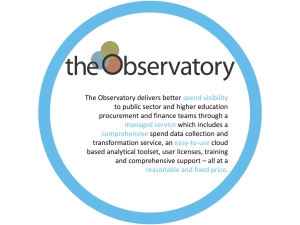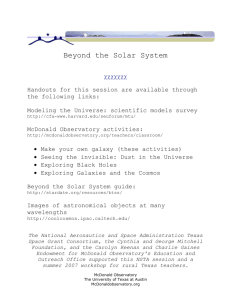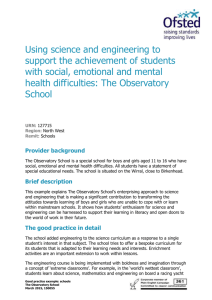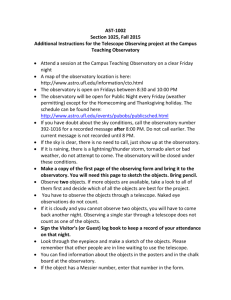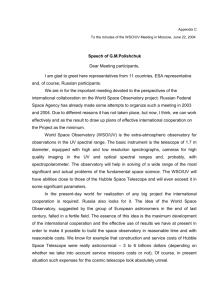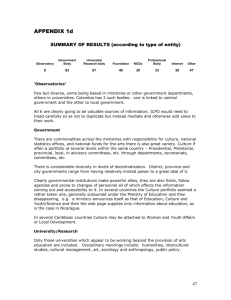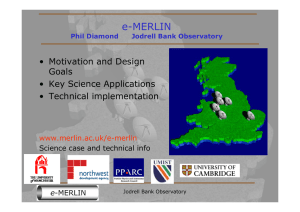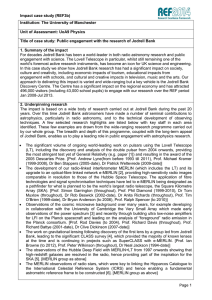Printable file
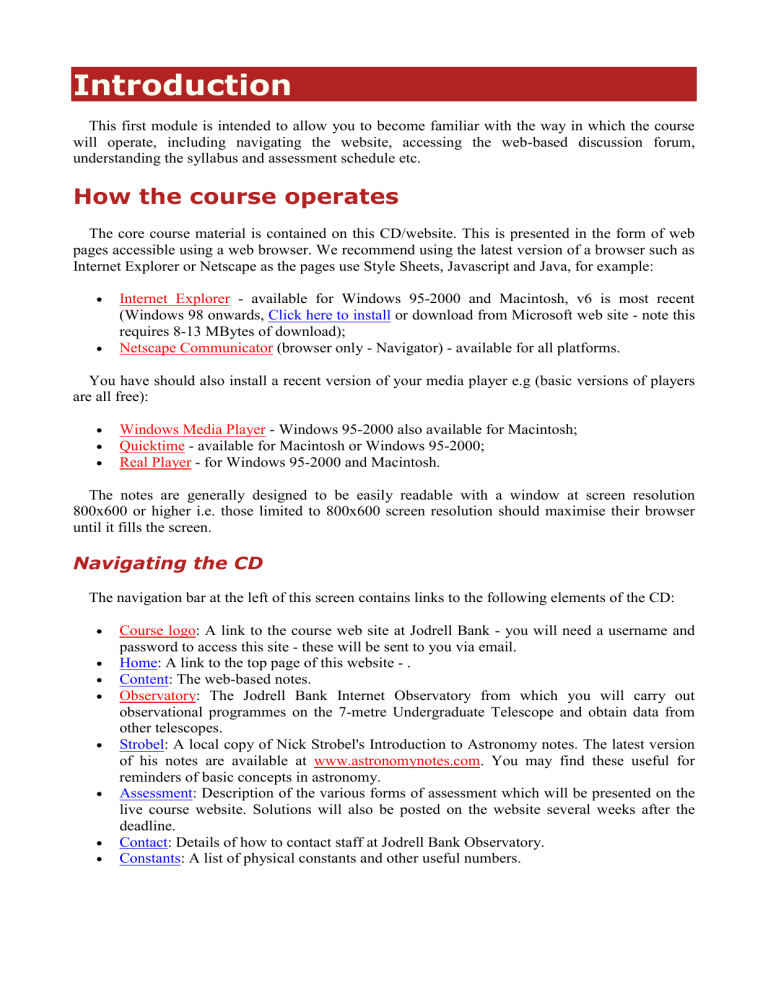
Introduction
This first module is intended to allow you to become familiar with the way in which the course will operate, including navigating the website, accessing the web-based discussion forum, understanding the syllabus and assessment schedule etc.
How the course operates
The core course material is contained on this CD/website. This is presented in the form of web pages accessible using a web browser. We recommend using the latest version of a browser such as
Internet Explorer or Netscape as the pages use Style Sheets, Javascript and Java, for example:
•
•
Internet Explorer - available for Windows 95-2000 and Macintosh, v6 is most recent
(Windows 98 onwards, Click here to install or download from Microsoft web site - note this requires 8-13 MBytes of download);
Netscape Communicator (browser only - Navigator) - available for all platforms.
You have should also install a recent version of your media player e.g (basic versions of players are all free):
•
•
•
Windows Media Player - Windows 95-2000 also available for Macintosh;
Quicktime - available for Macintosh or Windows 95-2000;
Real Player - for Windows 95-2000 and Macintosh.
The notes are generally designed to be easily readable with a window at screen resolution
800x600 or higher i.e. those limited to 800x600 screen resolution should maximise their browser until it fills the screen.
Navigating the CD
The navigation bar at the left of this screen contains links to the following elements of the CD:
•
•
•
•
•
•
•
•
Course logo : A link to the course web site at Jodrell Bank - you will need a username and password to access this site - these will be sent to you via email.
Home : A link to the top page of this website - .
Content : The web-based notes.
Observatory : The Jodrell Bank Internet Observatory from which you will carry out observational programmes on the 7-metre Undergraduate Telescope and obtain data from other telescopes.
Strobel : A local copy of Nick Strobel's Introduction to Astronomy notes. The latest version of his notes are available at www.astronomynotes.com
. You may find these useful for reminders of basic concepts in astronomy.
Assessment : Description of the various forms of assessment which will be presented on the live course website. Solutions will also be posted on the website several weeks after the deadline.
Contact : Details of how to contact staff at Jodrell Bank Observatory.
Constants : A list of physical constants and other useful numbers.
Clicking on the words Jodrell Bank Observatory at the bottom of the navigation bar will take you to the Observatory's home page and on The University of Manchester to the University's home page.
The course schedule
The course runs over about 24 weeks and is broken into separate modules covering a wide range of aspects of Radio Astronomy. If you do everything that each module contains i.e. read the web notes, work through the appropriate exercises, contribute to web discussions, browse any associated web links and complete the continuous assessment, we estimate you might study for an average of about 6 hours per week. Obviously this is not an exact science and the time an individual student will spend on the course will depend on many factors including prior knowledge, capabilities, special topics of interest and, not least, the time they have available. We also estimate that the minimum time you would need to spend studying each week in order to get something useful from the course is about two hours - this in effect means concentrating on the core web-based notes. You should also bear in mind that some modules may take longer to complete than others so treat the schedule as a guideline.
The web-based notes
As you already know these are accessed from the Content link on the navigation bar at left. They have been broken into modules which have a suggested starting date intended as a guideline for the rate at which you should work through the course. These notes will be distributed to you in several sections on CD and also made available on the live course website.
At the top and bottom of each set of notes there are arrows which are quick links to the notes from the module before and for the module following the current notes.
Self-assessment questions : In the notes there will be self-assessment questions designed to test your understanding of the material you have just read. The answers are available by clicking on the question mark symbol - this will pop up a small window which includes the answer plus more working if appropriate; clicking on the OK button in the answer window will close it. We advise you to carefully attempt to answer each question with reference to the preceding notes if required before you look at the answer - obviously this will provide a better test of your understanding. Here is an example...
How many hours per week should you expect to study for?
The WebCT Course website
The primary means for finding information about the course, including schedule, notes, assignments, discussion with other students and tutors is the WebCT home page. This can be accessed by clicking on the following link http://webct1.mc.man.ac.uk/ and entering the username and password which will be supplied to you as a separate email.
The Internet Observatory
The "Observatory" link connects you to the Jodrell Bank Internet Observatory. This is where you will access the observational programmes which form part of the course. These will include using the 7-metre telescope remotely over the internet to make observations of neutral hydrogen and map out the structure of our galaxy. It will also include access to the data which will be acquired with the
Lovell Telescope specially for students on this course. These observational programmes will take place once the first section of the course is completed.
Access to the Internet Observatory is by username and password - these will be supplied to you by e-mail in advance of this section of the course.
Discussion Forum
Exercise - Post a Message
We would like you to demonstrate that you are able to use the forum by carrying out the following exercise.
Exercise: Post an introductory message in the "Hello" section in the discussion forum. The message should briefly introduce yourself for the benefit of the other students. Please do this now (or as soon as you are able to get online).
Please contact your tutor if you have any problems.
Assessment
Details of assessment are given in the link in the navigation bar at left. The WebCT course website will give latest information on coursework specifications and deadlines. We are conscious that you will have many other demands on your time. If there is some reason why you do not feel able to meet a particular deadline please contact your tutor to negotiate an extension. We mark assessments anonymously i.e. the marker should not know whose work they are marking. The
"normal" means for submitting work should be electronically via the WebCT system. If this is not possible it can be sent either by post to Distance Learning at the usual Jodrell Bank address, or by email to Exploring@jb.man.ac.uk
. Work should have a coversheet containing the title of the course and the particular piece of work, your name and registration number. This coversheet will be detached by office staff before being distributed to the marker. Do not include your name on any other page of the work.
Contacting your tutor
The main course tutors are Ian Morison and Tim O'Brien. If you have any problems or questions regarding the academic aspects of the course you should get in touch with either of these people as soon as possible - see the "Contact" link in the navigation bar. Any queries concerning administration of the course e.g. payment of fees, change of address etc should be directed to Pat
Stanway, Sarah Morris or to the DL-INFO e-mail address.
Finally, make sure you can find your way round the website and contribute to the discussion forum.

